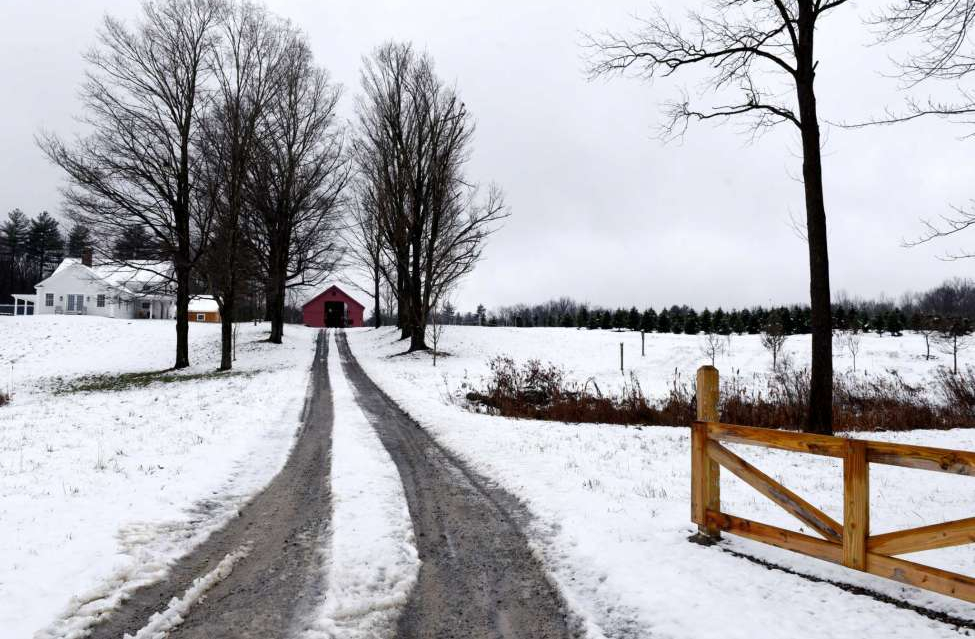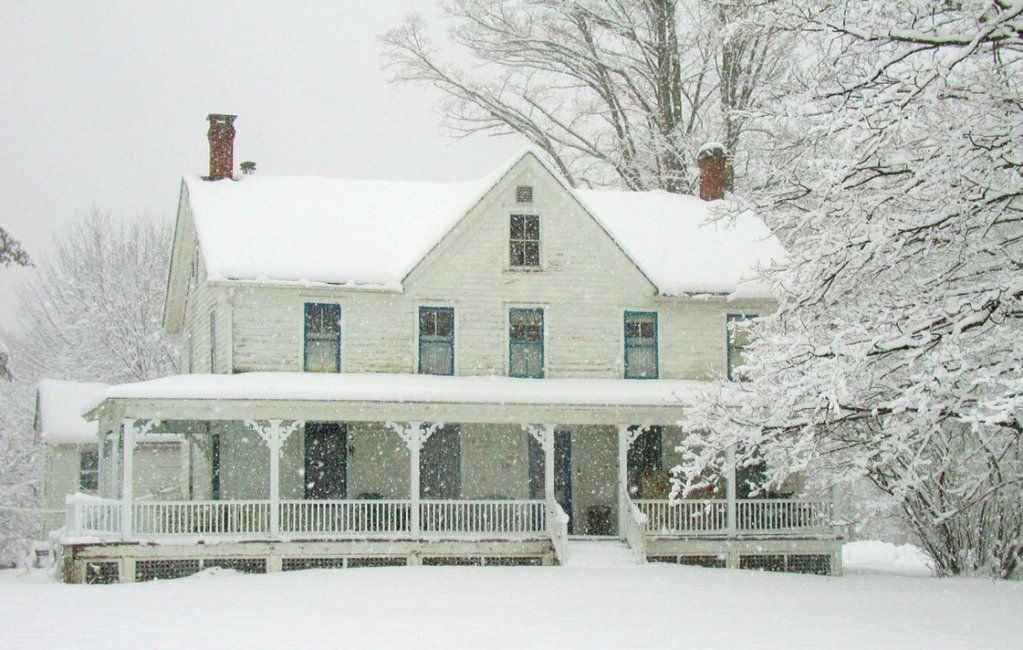The farm I grew up on in Stillwater, Minnesota, was the center of my universe from the time I was born until my grandparents sold it when I was 13. Development was getting too close to them – they bought another farm about 40 miles deeper into the northern countryside. This change coincided with the natural break that came for me as I shuffled off childhood and entered teen turbulence.
The origins of the farmhouse were from before Minnesota became a state in the 1850s. One of the first farmsteads in the St. Croix River Valley, the farm perched atop one of the highest hills around Stillwater. From the front porch, I could see for miles across the valley, with Lake McKusick down below to the tree tops miles away above the St. Croix River. A long, steep drive led from the winding country road – an extension of Stillwater’s Myrtle Street – to the house and barn.

The driveway was so steep that in winter it was often not possible to drive up or down after a heavy snow. Try going down without shoveling and you could end up off the driveway in deep snow. One side dropped off sharply into the sheep pasture. If your vehicle ended up down there, out came the tractor or – if the snow was really deep – Old Bird, our Percheron draft horse mare, the biggest one horsepower you could imagine. One of Grandpa’s friends thought he could make it up there after a snow. It took them half a day to pull his pickup truck out of the fence and back onto the driveway – mainly because we had to shovel the driveway first.
Many a morning after a big snow, my Grandfather and I shoveled that driveway. Grandpa was always up first to feed the stock. His dictum: animals eat first, then we eat. No exceptions. With a big snow, he was up extra early – usually by 4:30 – as water troughs had to be turned over to beat the ice out and fresh water pumped. I often participated in this exhausting work.
I usually tried to laze around under the covers until 6 or 6:30. Grandpa came in from chores and turned me out, saying every time: “You know, Steve, people die in bed.” And I always replied: “Yes, but they sleep there, too!” In the winter I usually slept on a massive overstuffed velveteen couch in the living room near the oil stove because it was too cold to sleep in the unheated rooms upstairs. I ran to the outhouse (no indoor toilet) for the morning ritual. There’s nothing like a trip to the outhouse when it’s 20 degrees below zero to wake you right up. I assure you: you won’t spend any longer in there than absolutely necessary. On my way back to the house, I stopped by the hen house to gather fresh eggs for breakfast later.
Then we shoveled. Fortified with something hot to drink and a pastry, we trudged through the snow to the bottom of the drive with our oversize steel scoop shovels. Then we worked our way to the top, one shovel full of snow after the other, stopping to catch our wind, stretch our arms, and straighten our backs. Grandpa showed me the most efficient way of shoveling the wet, heavy snow. Here’s how it goes.
First, look at where you were shoveling from and determine where you want that shovel full of snow to land.
Then grasp the shovel from the handle on top with one hand, placing your other hand at the point on the shovel where you could maintain the most leverage when the shovel was full – in other words, determine the most effective fulcrum point so that you would expend the least amount of effort with each shovel full.
Next, plant your feet in a position that would allow you to swing back, bend your back, pick up a full load of snow in the shovel’s scoop, then follow through in one motion – unbending your back only as much as was needed to deliver that shovel full to your target area.
If you had positioned yourself correctly, you could then take one small step forward or sideways as you were swinging the empty shovel back. When your arms had reached the end of the backwards swing, you could then be in position to repeat your actions. The effect was like using the shovel as a kind of balancing pendulum, stepping back and forth, seesawing your way up the hill, down the path to the pump house, out to the barn, and back to the farmhouse.
The lighter and drier the snow, the better this worked. Usually the dryness of the snow was also directly related to the temperature. At 20 below zero, the snow was dry and left the end of your shovel in a flurry. But at about 20 degrees above zero, the snow was heavy and tended to clump on your shovel. We waxed our shovels before shoveling this kind of snow, encouraging the wet snow to leave the shovel at the end of the swing.
The dry snow and cold temperature made for the best shoveling. You worked fast enough to keep warm, barely breaking a sweat.
Oh, that wet snow, though. It was far heavier than the dry stuff, and it didn’t like to leave the end of the shovel on your swing. Sometimes it fell short of the mark and you’d end up shoveling it up again as you made your way – not efficient. Soon you’d break into a sweat and have to take off a layer of clothing to cool down. And pretty soon the heavy, wet snow would start to take its toll on your back. It had to be shoveled all the same.
Shoveling the entire driveway took two to three hours. Then it was back to the house for a big breakfast. Grandma had been keeping an eye on our progress. When she saw that we were almost to the top, she started the frying pan heating on the wood cook stove and get the water boiling on the gas stove. By the time Grandpa and I had tramped the snow from our boots outside, left our outdoor clothing in the washroom, and cleaned up in the porcelain wash bowl in the sink, the air was filled with the alluring scent of eggs, bacon, hot bread or biscuits, and coffee.
Breakfast was a sit-down, family affair – a ritual. No one at the table touched a bite until Grandpa was seated. We bowed our heads while Grandpa would said grace. Breakfast sometimes started with hot cereal – creamed wheat, creamed rice, or oatmeal – topped with brown sugar. Grandpa and Grandma had their coffee, grounds boiled right in the water. I had hot chocolate mixed with fresh cream skimmed from the top of yesterday’s milk. Next came the main course, smoked pork chops, homemade sausage, thick sliced bacon, or lamb chops. There was also a big plate of soft-fried eggs in the middle of the table. Both Grandpa and I ate three eggs each; Grandma usually only had two. Sometimes there were potatoes, fried from last night’s leftovers.
Of course, there was bread and/or biscuits right out of the oven. Grandma baked bread every day or two. Grandpa wouldn’t eat store-bought bread. All that was available then at the store was puffed-up white bread, which tasted like Styrofoam and had about the same nutritional value. Grandma’s bread was whole wheat, light brown and somewhat dense, but fluffy inside that crispy crust. I liked mine toasted. So I would cut a two-inch slice, stick it with a long-handled cooking fork, take a cover off the wood stove, and toast it over the fire. Back at the table, I smothered it with home-churned sweet butter and used it to mop up the remainder of the eggs and meat drippings still left on my plate.
It’s hard to imagine being hungry after that. But if we were, there was always “smeckervesen,” as my German Grandma called it. We had an orchard, and the apple preserves lined the cellar walls for most of the winter. So Grandma would likely have some thick-crusted apple crisp available. If not, the pantry was full of molasses or oatmeal cookies.
A big teakettle of water was always on the stove, too, moved to the cooler area to keep warm, and then moved to the hotter area to bring the water to a boil. Often, a big pot of soup was simmering away, keeping just warm enough so you could always dip in for a bowl full. It stayed there for days. As we ate it down, Grandma added more ingredients – lamb, vegetables, or smoked pork. Barley was usually the soup’s base – my favorite. To this day, I’ve never tasted anything quite as delicious.
The farm is gone now. The hill where the farmhouse stood was leveled, divided into acre lots, and turned into suburbia. There is no trace of the old place, except for a tall stand of trees my grandfather and I planted together when I was a child. Perhaps, on a chilly morning in early winter, with a dusting of fresh snow on the ground, a mist rises from the low-land pond that could not be filled, and the 19th century farm hovers on the horizon, ghost of winters past. Gone, but not forgotten.


Thank you for sharing your memories of a different life, different world.
LikeLiked by 1 person
So far away, yet so close.
LikeLike
Wonderful Steven…I didn’t have the full life like you, but enough bits and pieces on cousin’s farms and the grandparent’s in town home with two chicken coops a bunch of rats and a haunted root cellar where fresh sauerkraut gurgled in the dark.
LikeLiked by 1 person
Thanks, Bill, and thanks for subscribing! Remembering and writing has to be one of life’s most pleasurable experiences. I have about 45 stories so far, including some favorite poetry. More to come!
LikeLike
Steve,
I enjoyed that beautiful story, which reminded me a little of my Eastern Washington childhood. We didn’t have to shovel snow, but my dad shoveled sometimes. We lived on a hill, so I think our car needed chains for the chilliest part of the winter, or good snow tires. We had a wood stove in the kitchen, and one of my favorite memories is the day my mother baked bread and made strawberry jam at the same time. That aroma and flavors are still in my memory. Our oil stove in the living room kept us fairly warm day and night. We had the best sledding hill in town, the edge of town. Mary Ann
________________________________
LikeLiked by 1 person
Thank you, Mary Ann! I can easily picture your family farm – very much the same in so many ways. I remember those wonderful odors as if I was still there. Give my best to Jack!
LikeLike
Thanks for this wonderful reminiscence of growing up in heartland America, Steve. A very enjoyable read.
LikeLiked by 1 person
Thanks very much, Tom. When I think back to those years, I realize what a privilege it was to have grown up in such surroundings, with such people. It gives me a certain peace of mind.
LikeLike
Reblogged this on SW COSGROVE.
LikeLiked by 1 person
This is a lovely bit of prose. I hope you will gather more wonderful tales in your new home in Brittany – how I envy you that move!
LikeLiked by 1 person
Merci bien, Christina! My hope is to spend much more time writing – tales to tell, stories begging to make the light of day. We bought Theresa’s Minneapolis – Charles de Gaulle flight ticket today. One way!
LikeLike